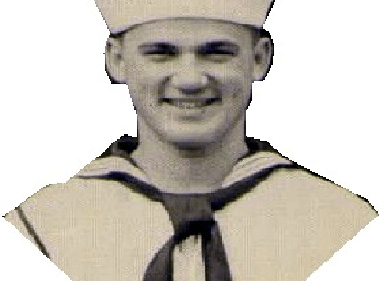Remembering
Torpedo Man 3rd Class Carmine Anthony Parziale (1921 - 1942)

US Navy, WWII, MIA/KIA, Purple Heart

Remembering - Torpedo Man 3rd Class Carmine Anthony Parziale by Evo G. Facchine
Wars are fought by brave men in many battle fronts on land, in the air and at sea, but certainly among the bravest men must be those that served under the sea in a submarine. Jay Township was not without such a brave hero who served in World War II in such a dangerous capacity.
That military man was TM3 Carmine (Carmen) A. Parziale, born in Weedville on April 11, 1921. He was the tenth of thirteen children born to Ralph and (Mary) Louise Cimenari Parziale. Mr. Ralph Parziale passed away at an early age; Carmine was little more than three years old. Mrs. Parziale later married Thomas Scarzo (Scott). Mr. Scarzo was arbitrarily given the name Scott by his employer.
To all that knew Carmine as a boy, a playmate and a student at Weedville School, he was a quiet, personable young man with a talent for music and a fine sense of humor, which he used to tease his mother and siblings. And, yes, according to some of his classmates, he brought his humor to the classroom. His popularity with his fellow students was evidenced by the many visits to his home by classmates during his absence from school while recovering from a rather serious sledding accident.
His talent at playing the trumpet led to his being part of a musical group called the Merry Makers, one of the first such groups formed in the Valley. Later it led to his being a member of the Navy Band. On a special occasion at a naval base in Newport, Rhode Island when the band played for the President of the United States, Carmine had the distinct honor of shaking hands with President Franklin D. Roosevelt.
After attending and graduating from the Weedville High School class of 1940, he enlisted in the Navy and was assigned to basic training for submarine duty. His training and first assignment was aboard the submarine USS Barracuda. At the inception of World War II with the Japanese attack on Pearl Harbor on December 7, 1941, Carmine was already a trained submarine naval seaman. In early 1942, he was reassigned to the USS Grunion (SS216). Ironically, this submarine was commissioned on Carmine’s twenty first birthday, April 11, 1942.
In keeping with his special personality, Carmine surprised his parents and family on his last furlough at home prior to his new assignment. During that time, he visited his alma mater and told the students that he loved the Navy. Typical of his humor was his telling the students, “After all, you have to eat beans at home sometimes, too.”
The Grunion, with some seventy officers and crew, sailed for the Pacific on May 24, 1942. A week later, as she transited the Caribbean Sea to the Panama Canal, she rescued sixteen survivors of the USAT JACK, a ship that had been torpedoed and sunk by a German U-Boat. This rescue is quite dramatically described in a letter from George F. Drew, one of the rescued soldiers, to Catherine Abele, wife of Lieutenant Commander Mannert L. Abele, Commander of the Grunion. Mrs. Abele then sent a copy of that letter to all the families of the men aboard the Grunion. The letter is in the possession of Sister Faye Buck, O.S.B., Carmine’s sister. She, along with Mrs. Francis (Mary Parziale) Gerber of St. Marys, is the only living member of Carmine’s immediate family.
The Grunion arrived in Pearl Harbor on June 20, 1942. Shortly thereafter, in fact on June 30, the Grunion was assigned to its first enemy patrol in the waters off Kiska Bay in the Aleutian Islands. On July 10, the Grunion immediately made her presence known by sinking two Japanese patrol boats and seriously damaging a third. The Grunion and other subs continued operating in the Kiska area and on July 30, after reporting increased anti-submarine activity in the area, was ordered to return to Dutch Harbor. Grunion never responded to that order and was never heard from again. The tragic loss of the Grunion and its crew of seventy officers and men remains a mystery to this day.
On that day it can be assumed Torpedo Man 3rd Class Carmine Anthony Parziale died. He was only 21 years old. It was not until early October that a telegram arrived informing the family that Carmine was listed as missing in action. Mean while, Lowell Thomas had already reported on a radio that the Grunion had vanished. On November 2, 1942, the Navy finally struck the Grunion from its list of active submarines. For the US Navy, the story necessarily ended there.
In each of these articles we actually find three stories: the story of the man, the story of his military organization and the story of those left behind. And now for that story.
At the time of his death, Carmine left behind his mother, Mrs. Louise Cimenari Parziale Scarzo; his step father, Thomas Scarzo; two brothers; six sisters; and numerous nieces and nephews. And yes a sweetheart named Genevieve, who went on to get married, have a family and is now deceased. Carmine’s mother was no stranger to tragedy for, by this time, she had lost her first husband and five other children. It is interesting to note here that there was another son, the eighth child in the family, also named Carmine, who died at the age of only ten days. In the tradition of Italian families at the time, the next male child would also be given that name and so it was for Carmine, the tenth child, the son that she hoped and prayed until her dying day would somehow be found and return. She would carry his last letters in her apron pocket and have her other children read them time and time again. In those times, Weedville had a train station. When the train stopped and blew its whistle in the early morning hours, she would ask one of her other children to go outside to see if Carmine was coming, again to surprise her as he did on his last furlough. Louise Cimenari Parziale Scarzo, according to Mary Lou Parziale Bentz, her granddaughter remembers that she always talked of her son “lost at sea.”
The name Carmine Anthony Parziale (Carmen) is carved in stone in various monuments from Pearl Harbor to Groton, Connecticut, and of course, in the monument in his hometown of Weedville—all in an effort that we might remember him and all the other brave heroes of that generation.
Mrs. Mary Louise Ciminari Parziale Scarzo and her family never forgot….
Finally, a little poem that some old time submarine survivors have written and is often read at military ceremonies for wives. Here, we will change the word wife and replace it with mother. It goes like this:
She stood at the Pearly Gate,
Her heart was beating fast,
She meekly asked the man of fate,
“Permission to go past.”
“What have you done,” St. Peter asked,
“To seek permission here?”
“I was the mother of a submarine sailor
For many a weary year.”
The gate swung sharply open
As old St. Peter hit the bell,
“Come in,” he said, “and take a harp.
You’ve served you share of Hell.”
“Lest we forget…”
